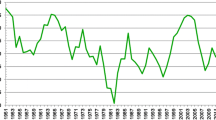Abstract
Firm-specific limits on capacity development rates (rates at which firms are able to increase output rate to design capacity) can affect firm performance in important ways, especially for firms involved in technological competition which introduce products relatively early. A simple model in which capacity development rates act in this way is developed and tested using data from semiconductor memory products (DRAMs). These results are used to estimate the ex post impact of increasing U.S. capacity development limits to the higher Japanese levels in the important 64 K DRAM generation.
Similar content being viewed by others
References
Abernathy William J. (1978) The Productivity Dilemma, Baltimore, Johns Hopkins University Press.
Abernathy William J. and Townsend Phillip L. (1975) ‘Technology productivity and process change’, Technological Forecasting and Social Change VII(4), 370–396.
Abernathy William J. and Utterback James M. (June–July 1978) ‘Patterns of industrial innovation’, Technology Review, 80, 40–47.
Abernathy William J. Clark Kim B. and Kantrow Alan M. (1983) Industrial Renaissance, New York: Basic Books, Inc.
Alchian Armen (1959) ‘Costs and Outputs’, In M. Abramovitz et al. (eds.), Allocation of Economic Resources: Essays in Honor of B. F. Haley (pp. 23–40). Stanford, CA, Stanford University Press.
Bohn, Roger E. (1985) ‘An informal note on knowledge and how to manage it’, April 19, Memorandum.
Bohn, Roger E. (1984) ‘Incorporating learning into managing and modelling production’, October, Manuscript.
Bohn, Roger E. (1991) ‘Noise and learning in semiconductor manufacturing’, Center for Technology, Policy, and Industrial Development and Sloan School of Management, Massachusetts Institute of Technology, March, Manuscript.
Clark Kim B., and Fujimoto Takahiro (1991) Product Development Performance, Boston, Harvard Business School Press.
Dertouzos Michael L., Lester Richard K. and Solow Robert M. (1989) Made in America, Cambridge, MA, The MIT Press.
Finan, William: Personal Communication.
Flaherty, Marie-Thérèse, and Webre, Philip (April 20, 1988) ‘Towards the micro-foundations of the learning curve and productivity: evidence from a semiconductor fab’, Manuscript.
Flaherty Marie-Thérèse (1983) ‘Market share, technology leadership, and competition in international semiconductor markets’, in R. S. Rosenbloom (ed.), Research on Technological Innovation Management and Policy, Volume 1, Greenwich, CT, JAI Press.
Flaherty, Marie-Thérèse (1982) ‘Market share determination in international semiconductor markets’, Harvard Business School Working Paper 1-782-009.
Flaherty, Marie-Thérèse (May 21–23, 1990) ‘Managing manufacturing and engineering in VLSI fabs’, IEEE/SEMI International Semiconductor Manufacturing Science Symposium, Proceedings, pp. 17–20.
Fudenberg Drew and Tirole Jean (1986) ‘A theory of exit in duopoly’, Econometrica, 54, 943–960.
Ghemawat Pankaj, and Nalebuff Barry J. (1985) ‘Exit’, The RAND Journal of Economics, 16, 184–194.
Hodges, David A. (1990) ‘VLSI manufacturing in Japan and the United States’, IEEE/SEMI Advanced Semiconductor Manufacturing Conference Proceedings, pp. 1–2.
Okimoto Daniel, et al., eds. (1984) Competitive Edge, Stanford, CA, Stanford University Press.
Prestowitz Charles V. (1988) Trading Places: How We Allowed Japan to Take the Lead, New York, Basic Books.
Raubitschek Ruth S. (1988) ‘Hitting the jackpot: product proliferation by multiproduct firms under uncertainty’, International Journal of Industrial Organization, 6, 469–488.
Tyson, Laura D'A., and Zysman, John (1989) ‘Developmental strategy and production innovation in Japan’, in Johnson, C., Tyson, L. D'A. and Zysman J. (eds.) Politics and Productivity, Ballinger Publishing Company.
Webre, Philip (1983) ‘Technological progress and productivity growth in the U.S. semiconductor industry’, Doctoral Dissertation, American University, Washington, D.C.
Whinston Michael D. (1988) ‘Exit with multiplant firms’, The RAND Journal of Economics, 19, 568–588.
Womack James P., Jones Daniel T. and Roos Daniel (1990) The Machine That Changed the World, New York, Maxwell Macmillan International.
Author information
Authors and Affiliations
Additional information
This paper was prepared as part of a larger project studying the cause of pervasive and persistent deficiencies in manufacturing performance and the causes of improvement in manufacturing performance in the U.S. and Japanese semiconductor industries during the 1980s. An earlier version of this paper was presented on January 4, 1992, at an Industrial Organization Session of the Allied Meetings of Social Scientists. The paper was improved by the comments and suggestions of the discussants at the meeting, F.M. Scherer and Philip Webre. It was further improved by the careful comments of Clement Krouse who organized the session as well as those of Richard Caves and Ruth S. Raubitschek, Sherri Goodman helped to assemble the data for computer analysis. Dataquest generously provided access to their data. The Division of Research of the Harvard Business School provided financial support. As usual, responsibility for all errors and omissions remains with the author.
Rights and permissions
About this article
Cite this article
Flaherty, M.T. Manufacturing and firm performance in technology-intensive industries: U.S. and Japanese DRAM experience. Review of Industrial Organization 7, 273–294 (1992). https://doi.org/10.1007/BF00353397
Issue Date:
DOI: https://doi.org/10.1007/BF00353397




